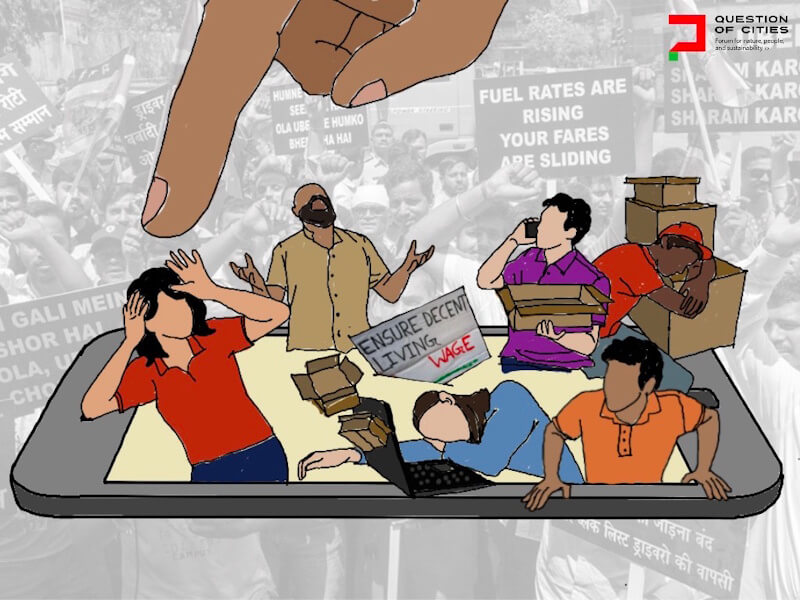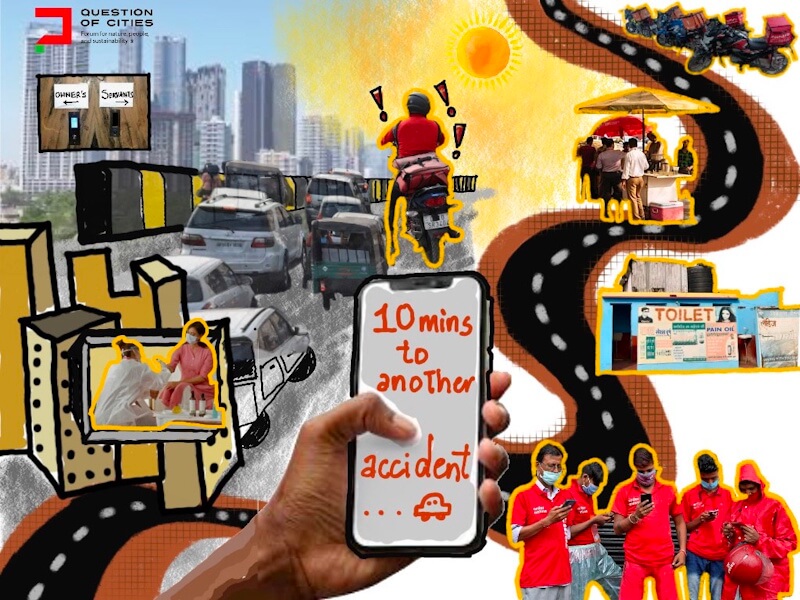“My biggest struggle isn’t traffic or distance, it’s dignity. I struggle to find toilets in the city. When I finally do find one between rides, it’s either locked or filthy.”
These are Shivam’s words laced with the anguish of being a platform worker for a ubiquitous ride-hailing and logistics delivery aggregator. Like thousands of platform workers or gig workers crisscrossing Delhi every day, Shivam’s workplace is not an office—it’s the streets, waiting areas outside restaurants, and parking lots. Yet, the way cities are planned and built, his presence is rarely acknowledged, let alone accommodated. Women gig workers have it tougher. Besides the hazards of working long hours in inhospitable conditions, they also contend with harassment, catcalling, and groping on streets that are dimly lit and deserted, as the engaging illustrations by Nikeita Saraf show.
The relationship between platform workers and the city is defined by their primary interaction with it as a place of work. They see the city as a place of aspirations and possibilities, as they describe it, but there’s another word they use most often: majboori or compulsion, helplessness. The city offers aspirations and hope, especially for migrant workers who form a large percentage of platform workers. Many take to gig work since it is easy to enter without training or qualifications. With its illusion of entrepreneurship and flexibility, it promises quick money.
The reality is starkly different. Aspiration and majboori are an inherent contradiction in gig work mirroring the contradiction in the city. The worker needs the city but it’s not home; the city needs the workers but does not accommodate them. In this, the workers lose out. Improving their working conditions is, then, an urban planning issue. This means accountability from not just the corporations they work for but also from the governments that plan and build cities, and authorities that make public policy.
A NITI Aayog report[1] (2022) showed there were 7.7 million gig workers across India – industry sources estimate it to be three times higher – and predicted 23.5 million by 2030. They are not legally classified as workers but considered “independent contractors” which means a lack of social security and increased precarity. Gig work has been well documented from these lenses. However, missing from the discourse is the crucial worker-city relationship.
The city as their workplace, coupled with algorithmic management, means the workers have little sense of what their day will look like, the kind of roads to navigate that day, where they will have lunch or stop for a bathroom break. What kind of a workplace, then, is the city? When the dominant narratives of a city are the imaginations of its elites, middle class, Resident Welfare Associations (RWAs), landowners, and corporates, where does the platform worker fit?

City as a hostile workplace
As governments and corporations turn public commons into private spaces, gig workers are impacted. It means having no access to resting or seating spaces, stripping the worker of dignity and violating the very principles of ‘decent work’.[2] Finding places to rest or use the bathroom is a concern. For example, Delhi has only 905 public toilets[3] while 52 percent of Bengaluru’s 803 are unusable.[4]
Resting spaces are also where workers charge their phones – a tool necessary for their job. With public spaces becoming increasingly exclusionary, RWAs frowning upon workers using their common areas, and workers not allowed to rest in parks, they find the city unwelcome. News reports in 2023 said that Zomato promised to build resting points in Gurgaon with high-speed internet, first aid, phone charging facility, washrooms and drinking water[5] but workers we know are unaware of it.
With most of them working 8-10 hours a day or more[6], they contend with extreme heat though government advisories[7] recommend minimising the time spent in the open in the afternoons. The lack of resting spots with cooling facilities, the lack of shaded areas in the city, and the lack of access to clean drinking water make matters worse. These are government-mandated amenities but rarely provided.
A survey by Telangana Gig and Platform Workers Union and HeatWatch in Hyderabad showed that 40 percent of gig workers there do not have access to clean and cold drinking water, over 60 percent lack access to clean washrooms, and more than 80 percent do not have a shaded resting area or cooling facilities such as fans.[8] In the absence of water dispensers, workers are forced to either carry large volumes of water from their homes or spend on buying water bottles every day.
It is not just their bodies but also their phones they worry about. As Shivam says, “During peak hours in the summer, we soak handkerchiefs in water and wrap them around our phones to stop them from overheating. If the phones shut down, we lose wages.” The time taken to cool phones or catch a breath is not considered productive time by platforms even if the worker is logged in.
Public infrastructure and gendered access
Women’s presence in the gig economy is largely in the beauty and wellness sectors but there has been a push by platforms lately to include more women in ride-hailing and hyperlocal delivery services too. “Majboori hai” says Delhi-based Saritha, five years after she began working. Having switched jobs four times across platforms, she has been with Swiggy for the past year. Access to toilets, safety at night, and overall job security are her primary concerns.
The situation in other cities is no different. According to a 2024 survey by Janpahal[9], the lack of functional toilets is a key barrier for women in gig work. Due to the skewed gender ratio in the sector, women’s voices often go unheard. The lack of public infrastructure adds a layer of marginalisation to the already precarious work that has been normalised by the platforms. They, however, voice their commitment “to increasing women in their fleets”[10]. Zomato partnered with the Brihanmumbai Municipal Corporation (BMC) to “empower women” with initiatives including maternal insurance, menstrual leave, and safety SOS features[11].
However, not mentioned in this partnership are steps to make the city more conducive for women gig workers, steps that fall well within the BMC’s purview such as toilets. As a report[12] the non-profit Praja Foundation shows, there is “currently only one public toilet seat in Mumbai per 1,820 females” against one for 100-200 recommended by the Swachh Bharat Mission.

The human cost of 10-minute delivery
Against this backdrop, the implications of 10-minute minute delivery are nothing short of hazardous. Swiggy launched Bolt, its “revolutionary” service, in October 2024. Soon, the Bengaluru traffic police noticed an increase in cases of reckless driving; the first week of November alone showed 1,700 cases[13] against delivery workers and spot fines worth Rs. 80 lakh (presumably borne by the workers) for wrong-side driving, driving without helmet, and skipping signals.
According to Swiggy’s quarterly market results[14], Bolt contributes to nearly 9 percent of the company’s food delivery volume. This is a case of extracting profit while offloading the risk onto workers. Official spokespersons from Swiggy have claimed there are no penalties for delayed Bolt deliveries[15] despite traffic violations pointing to a different picture.
According to Janpahal’s report, a staggering 87 percent said they felt unsafe when speeding to meet delivery targets. Iftikhar, an EV rider with a popular platform, says, “If the target is 20 orders and I complete 19, I lose the incentive. So, I’m forced to drive on the wrong side of the road. It’s scary.” Many say it should be at least 20-minute delivery, not an unrealistic 10 minutes.
Two questions arise. One, why are platforms allowed to continue the instant delivery services when the burden and risks fall on the workers? Two, despite traffic authorities identifying instant delivery services as a problem, why are they not being regulated?
Shift to EVs raises burden
Platforms like Zomato have pledged to achieve 100 percent EV-based (Electronic Vehicles) deliveries by 2033 to “reach net zero emissions across the food ordering and delivery value chain.”[16] But are our cities equipped? Gig workers struggle to find a functional charging station before the battery runs out, and long charging cycles mean extended wait times that platforms do not consider “work time” though charging is necessary for the job. A drop in tasks completed means a drop in ratings, and subsequently, a drop in earnings, they say.
Moreover, charging stations are not equipped with shelters; the long wait in severe heat raises the risk of heat stress. “Sometimes, you have to rush desperately before the battery dies, so you’re forced to drive recklessly. We always have to wait 15-20 minutes, sometimes even an hour, all without pay,” explains Ramesh, a Delhi-based worker with a delivery platform for the last 8 to 9 months.
Though cities are introducing public charging stations, access to them is limited. The Bangalore Electric Supply Company Limited, for instance, installed 310 public charging stations, of which only 166 were reported to be functional, as of Jan 2025.[17] Officials claim that the usage of existing stations is low which, experts argue, is because they have not been strategically located.
In Delhi, there were 1,919 charging stations and 232 battery swap points in March 2025.[18] However, charging pins, sometimes entire stations, are defunct. All charging stations in Delhi’s Connaught Place were out of order, with wires cut or guns missing.[19] Manoj, an operator at an EV swap point where depleted batteries are swapped for fully charged ones, says that if 3-4 riders arrive at once, they wait 20-25 minutes. “On far-away deliveries to Gurgaon or Noida where it’s difficult to find swapping stations, what if the battery dies mid-trip,” he asks.
Meanwhile, the Delhi government plans to install more charging stations, based on residential pin codes[20] of EV registrants and RWAs. Platform workers are not always owners of their EVs. This is an example of urban policymaking that leaves out the workers. Take the EV-aggregator, BluSmart, whose business model included charging stations and EVs. Once hailed as revolutionary, BluSmart unexpectedly suspended services on April 17 after the Securities and Exchange Board of India cracked down. Thousands of workers were jobless, overnight.
BluSmart’s case is not exceptional. The country’s EV ecosystem, marketed as sustainable, shifts the burden of operational and logistical management onto workers, and bites into their earnings.

What should be done?
The conceptualisation of the city as a workplace places the onus of worker well-being not only on the platforms but also on the state to build urban infrastructure to meet the evolving requirements of such work. This includes WASH (water, sanitation, and hygiene) accessibility, and functional EV stations in high-demand areas, besides urban infrastructure.
Months of relentless organising by the Amazon India Workers Union (AIWU) alongside Gig Workers Association (GigWA), forced national attention on the brutal working conditions that workers faced during the 2024 heat wave. Besides algorithmic transparency, fair wages, and the demand for legal recognition of workers as employees, unions have also been fighting the erosion of dignity which means securing mandatory infrastructure such as clean toilets, drinking water, and resting hubs.
The pressure, amplified by media scrutiny and public outrage, compelled Amazon to inaugurate its first resting point in India, named Ashray centres.[21] This is a start but justice requires structural changes. City governments must ensure that the workers have the right to the city they work in. Meanwhile, for the shift to EV, both the platforms and governments must together build the infrastructure required and ensure that workers have access to it. Platform worker unions should be involved in deliberations while building the EV infrastructure so that “green progress” does not become yet another burden for gig workers.
A key demand by GigWA is the formation of a tripartite board comprising workers, platforms or companies, and government nominees to address all such issues. States such as Rajasthan, through the historic Rajasthan Platform-Based Gig Workers Act, 2023, have built the framework for such a board. The tripartite board is essential to end the unilateral decision-making power that platforms currently enjoy.
Workers want more breathable and protective clothing from the platforms, a heat surcharge for working in peak afternoon hours, resting points with water dispensers and cooling facilities, and more shaded areas. For women workers, the demands include application of Prevention of Sexual Harassment provisions, improved street lighting, SOS buttons, creches and robust grievance redressal mechanisms besides resting places with clean and functional toilets.
The demands also include stopping platforms from unilaterally blocking worker cards, ensuring minimum pay for login hours, mandating comprehensive insurance coverage, and making Occupational Safety and Health rules applicable. The city administration must step up too. The provision of affordable housing, for example, is the state’s responsibility. Most gig workers live in rented spaces in congested neighbourhoods, sharing a room with 4-5 others. Heat mitigation measures by the state matter; most workers report body pain, extreme fatigue and headaches, which are exacerbated during heat waves.
Even as unions keep up the pressure on platforms, it is necessary that city governments and policymakers come together to build an improved and supportive workplace for gig workers, placing them in the city’s urban imaginaries.
Nitesh Kumar Das is the organising secretary of the Amazon India Workers Union (AIWU) and the Gig Workers Association (GigWA). He has been instrumental in building the union among Amazon warehouse workers in India. He has played a key role in exposing inhumane working conditions and unfair labour practices at the company. His work focuses on organising, advocacy, and building national and international networks. He holds a postgraduate degree in Development Studies from Azim Premji University.
Anusha Bhat is a researcher and health communication strategist based in Bangalore. Her work explores the political economy of labour and public health, particularly in urban settings. Her writing on labour rights and inequality in neoliberal cities has appeared in publications such as The Deccan Herald. Anusha holds a postgraduate degree in Development Studies from Azim Premji University.




